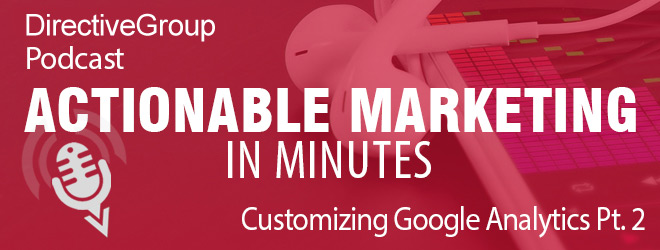In this episode of Actionable Marketing In Minutes we have the second part in our series about customizing Google Analytics.
Use the player below to listen to this episode, or the download link to load it on your device for listening later. You can also find our RSS feed by clicking here, or subscribe by email in the sidebar to the left.
Download our Marketing To Millennials eBook here!
Not able to listen? Why not read the episode transcript below:
Problem:
During our last podcast, we discussed the ways to customize data collection in Google analytics. In this session, we will discuss the customization of reports. If Google analytics offers standard reports, why should you use custom data reporting? Because reporting customization in Google analytics helps you to see all the data you need in a quick glance. You can collate all the required data points related to your business with ease. After all, its reports that tell us whether or not our efforts are actually generating results, guide us in our strategy or program shifts, and show us the bigger picture. And now we can tweak and customize the reports to show us exactly what we need to see in order to make smart business decisions.
Solution:
Just like with data collection, there are a variety of ways to customize your GA reports. Today we are going to talk about using shortcuts, dashboards, custom reports, advanced segments, and Data Studio.
* Shortcuts: These are easy ways to access the reports you frequently visit. Shortcuts remember your settings so you don’t have to reconfigure a report each time you open it. When you use this feature, the setting you apply to a report, such as adding an advanced segment or a new metric, will stay applied in the shortcut until you manually change the settings. The settings are saved even if you sign out and sign back in to your account.
* Dashboards: Google Analytics Dashboards are simply collections of widgets that allow you to quickly visualize your data. Dashboards are relatively common with just about any online tool or platform and let you easily manage your account.
* Custom Reports: This one is pretty self explanatory. With the custom reports feature, you pick the dimensions and metrics and decide how they should be displayed.
* Advanced Segments: When you use advanced segments you are able to create subsets of users. This is exciting because it allows you to study the behavior of users based on the segments you create.
* Data Studio: The last custom report setting we’re going to talk about is the Data Studio setting. Just released a few months ago, Data Studio is free for individuals and smaller teams. Data Studio lets you connect to all your marketing data and turn that data into beautiful, informative reports that are easy to understand, share, and fully customizable.
While there are certainly more customization options with Google Analytics, that’s all we have time to cover today. If I could leave you with just one more thought it would be that analytics are one of the, if not THE, most important part of any marketing strategy or program. GA offers so much data that you could end up lost in a rabbit hole trying to figure out which end is up. Therefore we recommend taking a course or working with Google Analytic experts to develop the most powerful and informative reports for your business.
We hope you’ve found this information helpful. Please connect with us on Twitter @DirectiveGroup or on LinkedIn. Let us know what you think and what you’d like to hear about next. And if you like our podcasts, please share with your networks using hashtag #actionablemarketing. Join us for an upcoming episode where we will dive into changes in mobile advertising.
Podcast: Play in new window | Download (Duration: 4:59 — ) | Embed
